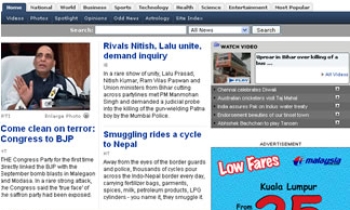AT The Guardian, they claim that they came up with the idea of a compact newspaper long before The Independent.
In August 2003, so the story goes, the paper’s editor, Alan Rusbridger, returned from a holiday brandishing a copy of the Italian newspaper La Repubblica.
Executives at The Guardian had been looking at the possi-bility of a tabloid edition for months, worried by market research that showed that the broadsheet was increasingly unpopular.
Editorially, however, they were reluctant to make the move, which tended to limit the space on each page to just one story under a strident tabloid headline. La Repubblica – physically halfway between a broadsheet and a tabloid – might offer a way around these obstacles, Rusbridger said.
One month later, The Independent launched its compact edition and, six weeks after that, The Times followed suit.
"When the Indy went tabloid, it really focused the mind," said Carolyn McCall, chief executive of Guardian Newspapers Limited.
Ever since then, however, McCall has had to sit back and watch as its rivals won new readers, about 25,000 of them from The Guardian.
Tomorrow The Guardian hits back. The launch of its own full-colour "Berliner" edition will be trumpeted in a national advertising campaign that includes television, poster and online ads, and even a double-decker bus touring the capital.
The move represents a gamble with both the reputation of a 184-year-old institution and £80m of capital investment.
McCall said she expected the paper to recoup this outlay within 15 years, with much of the increased revenue coming from the higher advertising premiums that full-colour advertising would attract.
Tara Marus, director of the media-buying firm BJK&E, said advertisers were already showing keenness to buy space in the new paper. In contrast, Marus said that advertising revenues at The Times and Independent had suffered after the move to compact editions.
"The Berliner is a great individual product when compared with The Times and Independent, which tried to do something different and didn't really retain their quality position," said Marus.
But, for McCall, the main driver behind the move is circulation. While refusing to give explicit targets for the number of readers she hoped the new edition would attract, she wanted at least to win back what market share the paper had lost.
"There is no point in lying. I expect most of the lapsed readers who filed out to other formats to come back. I really do," she said.
The launch of the Berliner comes at a time of change in the newspaper industry. In the past year, daily sales of The Guardian have fallen by 6.3%, to about 340,000, its lowest since August 1978.
Sales of The Independent are down slightly over the same time, to about 256,000, but remain about 40,000 higher than on its final day of sales as a broadsheet. The Times is up 60,000 since it went compact, at about 680,000.
The Times is now seeking to consolidate these gains by introducing a 5p increase in its cover price, to 60p, generating an estimated £8m and effectively calling an end to the price war between the nationals that has lasted since 1993.
Faced with these gains, only the Financial Times and The Daily Telegraph have remained steadfast in refusing to change the size of their papers.
Of these, the Telegraph is held back by the average age of its readers – 56 – who are more resistant to change than the younger readers of its rivals. To secure its position, however, the Telegraph is now planning a marketing push.
Working with ITV, WH Smith and Penguin, the newspaper is planning to offer readers a series of free and discounted British television dramas on DVD over the next three months.
The Financial Times appeals to a specialist market, but it, too, is under attack. Last Monday saw the launch of City AM, a free newspaper aimed at London’s business community.
On its first day the paper distributed a reported 60,000 copies, although this figure is yet to be independently verified. It is now aiming for 100,000 a day by the end of the year.
Analysts remain sceptical, however, about whether the paper’s distribution model will prove effective.
The Daily Mail also wants to grab some new readers in this increasingly crowded market. In January, it will launch an Irish edition, which it hopes will increase local sales from 8,000 to about 20,000.
Associated Newspapers, the owner of the Daily Mail, is also planning the launch of a Dublin edition of its free Metro news-paper, which has proved successful in Britain.
The biggest change, however, has been driven by the internet, and it is here that The Guardian finds itself the victim of its own success.
Guardian Unlimited, the newspaper’s website, is the most successful of its kind in Britain, with more than 11m individual visitors in July, compared with 6.4m for The Times Online website.
Analysts said that much of The Guardian’s recent losses were caused not by the machinations of its rivals, but by increasing numbers of its own readers moving to the online edition.
"When we have got something so brilliant that is free, you are bound to lose some readers," said McCall. "All you can do is offer a successful new product to bring people in. We have this formidable property in Guardian Unlimited and we want there to be a match."
The new Berliner edition would introduce much more cross-fertilisation between the internet and print versions, with each promoting the other, she said. Ultimately, however, this may prove only a stop-gap measure.
Lorna Tilbian, media analyst at Numis Securities, said that a long-term decline in newspaper readership had been accelerated by the internet.
"It is no longer an economic cyclical thing, it’s a structural change. People now want their news the same day and the internet can deliver."
In its attempt to struggle against this trend, The Guardian has spent more on its Berliner edition than if it had followed The Independent and Times in producing a compact.
Because of the size of this spending – £80m – the Berliner risks being judged a failure if it does not significantly lift sales.
Tilbian, however, is sceptical as to what success can actually be achieved.
"I think it would be a success if The Guardian’s existing circulation goes up," she said. "But I don't think it can go past where it was before the Indy launched its tabloid edition. That would be too extraordinary."









